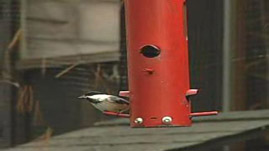Teachers' Domain - Digital Media for the Classroom and Professional Development
User: Preview

Source: Outside
In this video from WPSU’s Outside, a staff member at Shaver’s Creek Environmental Center at Penn State University provides tips on backyard bird feeding during the winter. Topics include the selection, placement, and cleaning of feeders. To attract birds for viewing, and to contribute to their welfare, it is important to understand their needs and behaviors. Placing a bird feeder close to a window will prevent collisions with glass. Offering seeds and suet can provide birds with the energy they need to fly. A container can hold clean water, while an electric bird bath heater will keep it from freezing.
To attract birds to a feeder, it is necessary to understand their needs and behaviors. Contrary to the expression "eats like a bird"—meaning that someone doesn’t eat much—birds actually eat large amounts of food to generate the energy they need to fly. Some birds migrate each year in search of a warmer climate or better food. As they journey through urban and rural areas, birds may stop at your backyard birdfeeder. Whether the birds are traveling short distances or thousands of miles, seeds and suet can fuel their flight by providing the energy they need.
For example, American robins may stop at a bird feeder in winter when berries are scarce. An adult robin needs approximately 40 calories a day. While some robins stay north and move around in search of food, the majority of them migrate south in the winter. To gather enough energy for long trips, robins eat a lot of food before they travel. By contrast, robins that don’t migrate at all need less food for energy. When robins migrate north in the spring, they travel along a path of places with average temperatures of 36°F. An age-old theory suggests that robins move seeking warmth, but a current theory proposes that they are looking for available food.
Different species of birds are partial to different birdfeeders. Some popular styles are platform, tube, or hopper style feeders. Hummingbirds, for example, like tube feeders with a liquid sugar solution that tastes like nectar. Goldfinches prefer hanging feeders with small feeding ports to discourage bigger birds from hogging food. Larger birds, like blue jays, enjoy platform feeders with room to toss around seeds and nuts. Regardless of style or shape, all feeders should be cleaned regularly with soap and water, and occasionally with bleach.
All birds need clean water not only for drinking, but also for bathing. In winter when it’s difficult to keep water from freezing, break up the ice in the birdfeeder, or use an electric heater.
Human landscapes can endanger birds. Estimates are that each year at least 100 million birds die in North America by colliding with glass. To avoid this hazard, place a birdfeeder in a sheltered spot with a fine mesh net between the feeder and the window, or place the feeder close enough to the window so birds can’t gain enough momentum to hurt themselves.
In urban habitats, birdfeeders can provide places where many people can enjoy birds. Birdfeeders can be installed in parks or on plots in front of a building. Cornell’s Lab of Ornithology is collecting data from city dwellers to learn which birds can survive in cities, where these birds live, and how birds behave differently in cities than in other places.
To learn more about birds' eating habits, find out what the shape of a bird’s beak can tell us about what it eats in Bird Food.
To learn more about bird migration, check out how a tiny hummingbird journeys from Alaska and California to Mexico every year in Little Brain, Big Journey.
To learn more about how to study birds, check out how Jarrod Santora bands a bird and gathers other information to determine how and where birds live in An Ornithologist’s Job.
 Loading Standards
Loading Standards